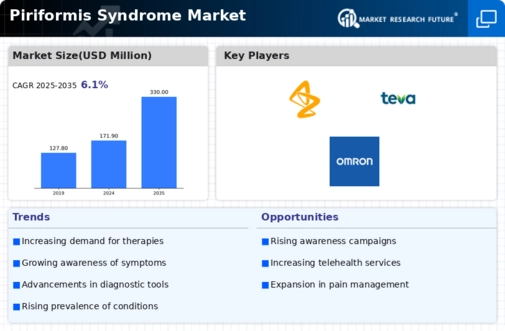Market Growth Projections
The Global Piriformis Syndrome Market Industry is projected to experience substantial growth over the next decade. With an estimated market value of 171.9 USD Million in 2024, the industry is expected to reach 330.0 USD Million by 2035. This growth trajectory suggests a compound annual growth rate of 6.11% from 2025 to 2035. Such projections indicate a robust demand for effective treatment options and highlight the increasing recognition of Piriformis Syndrome as a significant health concern. The market's expansion reflects the ongoing efforts to improve patient care and enhance treatment modalities.
Increased Awareness and Diagnosis
The growing awareness of Piriformis Syndrome among healthcare professionals and the general public is a significant driver for the Global Piriformis Syndrome Market Industry. Enhanced education and training for clinicians lead to more accurate diagnoses, which in turn encourages patients to seek treatment. Public health campaigns and resources available online contribute to this awareness, helping individuals recognize symptoms earlier. As a result, the market is likely to see an increase in demand for diagnostic tools and therapeutic interventions. This heightened awareness is expected to support the market's growth trajectory, with projections indicating a rise to 330.0 USD Million by 2035.
Integration of Telehealth Services
The integration of telehealth services into the management of Piriformis Syndrome is transforming the Global Piriformis Syndrome Market Industry. Telehealth offers patients convenient access to healthcare professionals, particularly for those in remote areas or with mobility challenges. This shift not only enhances patient engagement but also facilitates timely diagnosis and treatment. As telehealth continues to gain traction, it is likely to expand the reach of healthcare providers and improve patient outcomes. The ongoing evolution of telehealth services may further stimulate market growth, as more patients utilize these platforms for managing their conditions.
Advancements in Treatment Modalities
Innovations in treatment options for Piriformis Syndrome are propelling the Global Piriformis Syndrome Market Industry forward. Recent advancements include minimally invasive surgical techniques, physical therapy, and the use of targeted injections. These developments enhance patient outcomes and reduce recovery times, making treatment more appealing. Furthermore, the introduction of new therapeutic devices and medications is likely to improve the management of this condition. As the market evolves, it is anticipated that the Global Piriformis Syndrome Market will experience a compound annual growth rate of 6.11% from 2025 to 2035, driven by these advancements.
Rising Prevalence of Piriformis Syndrome
The increasing incidence of Piriformis Syndrome is a notable driver for the Global Piriformis Syndrome Market Industry. Factors such as sedentary lifestyles and the growing aging population contribute to this trend. Reports indicate that the prevalence of this condition is rising, particularly among individuals engaged in repetitive activities or prolonged sitting. As awareness of this syndrome grows, more patients seek medical intervention, thereby expanding the market. The Global Piriformis Syndrome Market is projected to reach 171.9 USD Million by 2024, reflecting the urgent need for effective treatment options and management strategies.
Growing Demand for Rehabilitation Services
The increasing demand for rehabilitation services for individuals suffering from Piriformis Syndrome is a crucial driver for the Global Piriformis Syndrome Market Industry. Rehabilitation programs focusing on physical therapy, exercise regimens, and pain management are becoming more prevalent. This trend is largely influenced by the rising number of patients seeking non-invasive treatment options. As healthcare systems prioritize rehabilitation to improve quality of life, the market is expected to expand significantly. The emphasis on holistic approaches to treatment aligns with the growing preference for personalized care, further supporting the market's development.













